Fully Support Children’s Creative Expressions
Divide the arts into categories, creative dramatization music, purposeful movement and visual arts.
The process of experimenting and expressing or creating art is a way that children can synthesize all that they are learning about the world, especially the natural world.
Dramatic play can be interpreted and understood through the ways children engage in elaborate and imaginative play, showing us what they are thinking and how they are making sense of what is going on around them.
When children use parts of natural objects, such as stumps, sticks, and pine seeds, that play is taking on a new richness- ask them to come up with their own ideas and create their own accessories. Sometimes they get immersed in an enchanting world of fantasy for a while.
Music and Movement
Nature, music and movement work very well together. We know that all children, but especially those who are truly kinesthetic, need to move in order to learn. By helping them learn what their bodies are capable of and how to regulate it, the natural outdoor classroom provides the space for children to engage in a wide variety of movements, even including real jobs like digging holes and raking leaves. When musical instruments are available every day, children often link their movements to music. They can jump like a friend beating a drum or float like a butterfly, dancing with handkerchiefs.
Another unique opportunity that the outdoors offers is the practice of attentive listening. Children develop valuable musical understanding as they try to match the notes played with their voices or experiment with pitch and volume. One child that I observed in an outdoor classroom would regularly watch and listen to birds and then try to call and respond with them, hoping they would enjoy her songs as much as she enjoyed theirs.
Visual arts
Consider how the aesthetics of environments support creativity.
The beauty of nature inspires much of the art we see in museums and elsewhere, so it should come as no surprise that children respond in the same way.
Developmentally appropriate practice calls for us on the process of creation rather than the product, and outdoor art areas can truly inspire children’s processes.
Processes can include stone mosaics, mud paintings on easels and sidewalks, and snow sculptures waiting for the warmth of the sun to melt them into new shapes. The great messy artwork that can happen with materials like these that can ensure that artistic creation is a very sensory experience.
Creativity is inventing, experimenting, growing, taking risks, breaking rules, making mistakes, and navigating.” Learning to interpret the world around us so that we can find our place in it and be able to contribute to it. That is what education is all about. Creativity is the way children express their uniqueness.
When they make stories, make music, draw, they make visible what they know, what they feel and who they are. We can learn more from our children.










